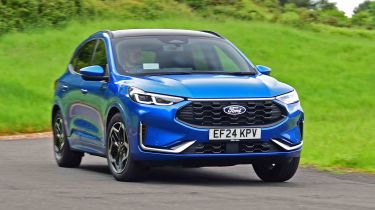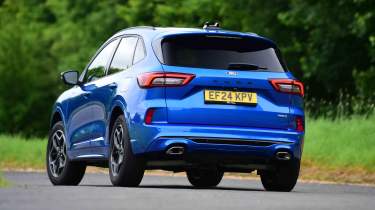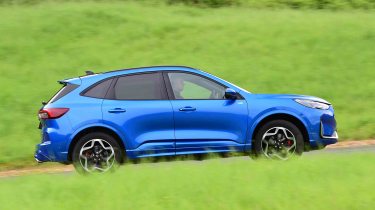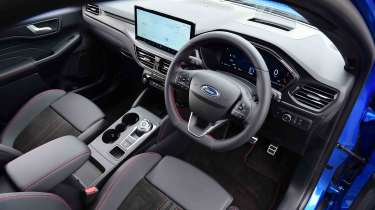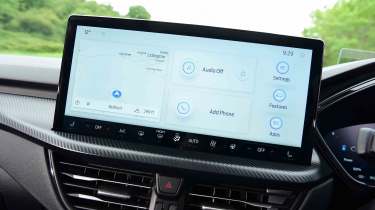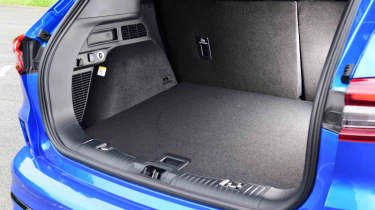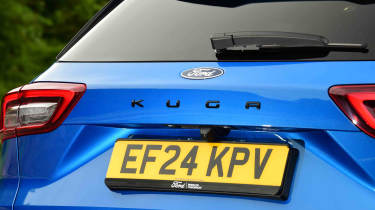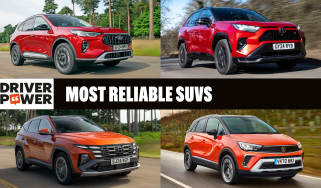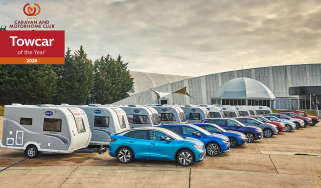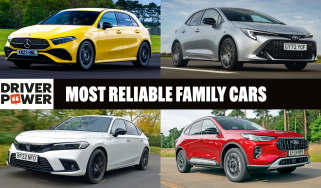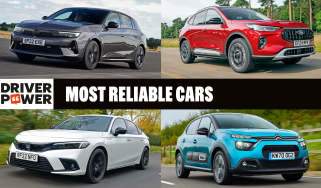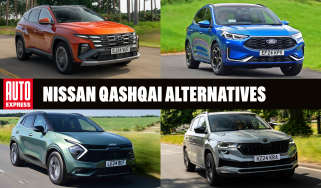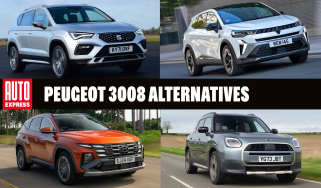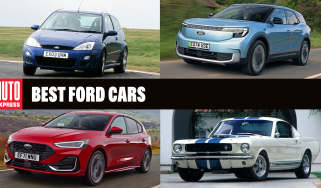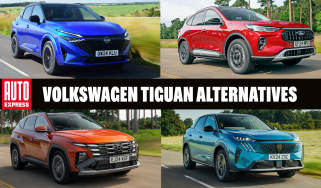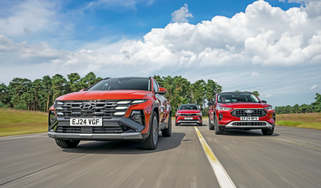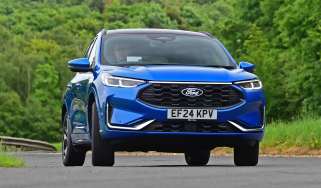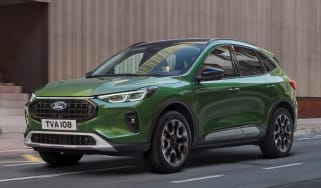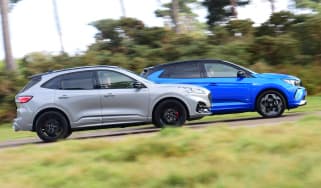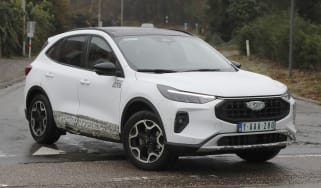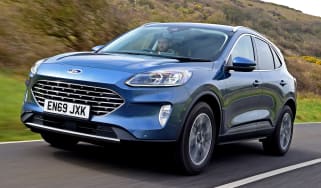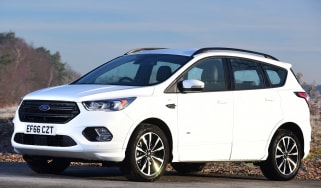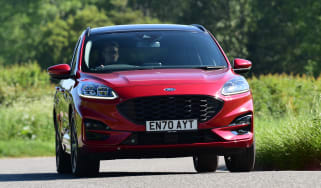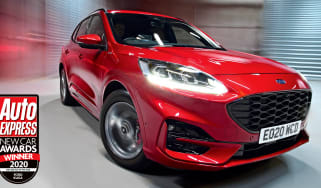Ford Kuga review
Practical and efficient yet still great to drive, the Ford Kuga is an appealing family SUV

Our opinion on the Ford Kuga
The third-generation Ford Kuga is easily the best iteration of this family SUV that the brand has produced so far. While it provides essential touches such as useful on-board tech, good safety kit and plenty of practicality, it also boasts genuinely impressive driving dynamics — a typical Ford party piece.
Unfortunately, some obvious cost-cutting measures mean the Kuga doesn’t have the plushest interior compared with its close rivals, but the overall package still remains compelling. With efficient hybrid and plug-in hybrid models available and competitive prices across the range, the Kuga offers exceptional value for keen drivers who need a little more room for the family.
About the Ford Kuga
A quick look at the Ford Kuga family tree reveals that the first generation of this family-friendly SUV, launched in 2008, was little more than a high-riding Ford Focus. This was a good thing, though, and meant customers were treated to hatchback-style handling, while benefiting from the extra space and practicality of the larger five-door family car.
Ford’s latest crack at the Kuga greatly improves on this formula, and the brand’s engineers have concentrated on all the essential areas, providing the Kuga with eye-catching good looks, decent levels of standard kit, an efficient range of engines, and solid safety credentials. It drives rather well, too, as we’ve come to expect of Ford’s European SUVs.
Used - available now
The third-generation Kuga is based on Ford’s C2 platform, which shares its underpinnings with the retired Focus hatchback. This means there’s more driving enjoyment to be had than in rivals such as the Honda CR-V, Hyundai Tucson, and Toyota RAV4.
A revision to the engine range in 2021 saw Ford completely remove diesel power from the Kuga line-up. The engine choices now consist of a 1.5-litre EcoBoost petrol, a full hybrid, and a 2.5-litre plug-in hybrid. The 1.5 Ecoboost engine is paired solely with a six-speed manual transmission, while the hybrid and plug-in hybrid models use a CVT automatic gearbox.
Ford Kuga prices and latest deals
Prices for the Kuga start at £32,695 for a 1.5 Ecoboost in Titanium trim, which is only a few hundred pounds short of a firm Auto Express favourite, the Hyundai Tucson. There’s a big jump in price for the next trim level up, ST-Line, which starts from £37,715. A smaller financial leap is needed to get into an Active trim, starting at £38,225, while the ST-Line X, ST-Line X Black Package and Sound Edition variants all cost more than £40,000.
If you spec your perfect Ford Kuga through the Auto Express Buy a Car service, we offer average savings of around £3,200 on this mid-size SUV. Alternatively, there are plenty of new Ford Kugas in stock and ready to hit the road from £27,000. You can also find plenty of affordable used Ford Kugas on sale, too.
Engines, performance & drive
Pros |
|
Cons |
|
Ford has fitted the third-generation Kuga with a strong range of engines and made it a family SUV that’s also great to drive. The suspension stays comfortable and composed in most situations, although we did find the ride slightly too firm and bouncy on the ST-Line X version with its sporty suspension and larger alloy wheels. Smaller wheels go towards making the Kuga more refined.
If you want another mid-size SUV that’s as engaging to drive as the Ford, you’ll have to look towards the likes of the BMW X3. However, this sits at the premium end of the market, which means a far more significant starting price of over £50,000.
| Model | Power | 0-62mph | Top speed |
| Kuga 1.5l EcoBoost 150PS 6 Speed FWD | 148bhp | 9.5 seconds | 121mph |
| Kuga 2.5l Duratec FHEV 180PS CVT Automatic FWD | 178bhp | 9.1 seconds | 122mph |
| Kuga 2.5l Duratec PHEV 243PS CVT Automatic FWD | 240bhp | 7.3 seconds | 125mph |
Performance, 0-60mph acceleration and top speed
The 1.5-litre EcoBoost petrol engine provides 148bhp and 240Nm of torque, and manages the 0-62mph sprint in 9.7 seconds, with a top speed of 121mph.
Next up is the 2.5-litre FHEV hybrid, with the front-wheel-drive model producing 178bhp and 200Nm of torque. Opting for the ST-Line X adds the option of four-wheel drive, and this produces the same amount of torque, but with a little more power at 181bhp. The FWD car gets from 0-62mph in 9.1 seconds, while the 4WD model is a little quicker at 8.3 seconds. Both top out at 122mph.
The fastest Kuga is the 240bhp 2.5-litre PHEV plug-in hybrid, which completes the same sprint in 7.3 seconds and romps on to a top speed of 125mph.
Ford has fitted selectable driving modes as standard, so you can cycle between settings designed to cater for eco, sporty and off-road driving. Naturally, you’ll want the four-wheel-drive model if you want the best performance in the rough stuff. That said, the Active trim’s raised ride height makes it the better option for conquering (slightly) rougher terrain.
Town driving, visibility and parking
Although there’s no mistaking the Kuga’s size from behind the wheel, the fine all-round visibility helps prevent any major mishaps when squeezing through narrower gaps. There was the odd occasion where the cars’ A-pillars did prove a little obstructive during testing, but this was a fairly minor and infrequent frustration.
While this visibility does help during parking, the whole Kuga line-up is fitted with front and rear sensors as standard, while entry-level Titanium models also have a reversing camera. Moving up through the rest of the range upgrades this to a 360-degree camera, but both systems help to make parking far easier.
Country road driving and handling
Much like the smaller Ford Puma does in the small SUV market, the Kuga offers some of the highest levels of driver engagement that you’ll find in the mid-size SUV sector. MacPherson strut front suspension and a multi-link rear set-up help with agility when pressing on through corners, while the steering provides a decent level of feedback without feeling too heavy. The ST-Line and ST-Line X benefit from sports suspension for maximum cornering thrills, but the Active also puts on a good show even though its height is raised by 10mm at the front and 5mm at the rear.
When you need to rein it in, the Kuga’s brakes are strong but easily modulated.
Motorway driving and long-distance comfort
While it helps greatly with the Kuga’s agility, Ford’s suspension set-up does follow the typical rule of sporty handling resulting in a firmer ride. This is even more obvious in the ST-Line and ST-Line X models with their sports suspension, but the Kuga certainly isn’t uncomfortable. In fact, it does a reasonably good job of absorbing the majority of Britain’s road surfaces.
For the most pleasant long-distance trips, though, we advise opting for one of the lower-spec cars with the smaller 17 or 18-inch wheels, because larger alloys can cause the Kuga to feel a bit fidgety at motorway speeds. We also found that tyre noise was more noticeable in the Ford than in the Hyundai Tucson and Vauxhall Grandland when we compared the three cars in a test.
Overall, the Kuga feels more like a regular family hatchback than a high-riding SUV, but keen drivers probably wouldn’t choose the hybrid version. While the petrol engine kicks in smoothly, it can sound a little strained under acceleration, particularly due to the droning nature of its CVT gearbox.” - Alex Ingram, chief reviewer.
MPG & running costs
Pros |
|
Cons |
|
A key feature of a family SUV like the Ford Kuga is its ability to offer reasonable running costs, and the Kuga has this area covered. The petrol models can return over 42mpg while emitting up to 154g/km of CO2, and company car drivers can reap some tax benefits from the 21 to 23g/km emissions offered by the PHEV model.
The latter also offers very strong fuel economy with a WLTP combined figure of 313.9mpg. Of course, achieving this in the real world will be difficult, but we think it’s reasonable to expect similar economy to an equally powerful diesel. You’ll need to keep the battery topped up, though.
If you don’t like the idea of a plug, the full-hybrid (FHEV) is another efficient option that officially manages up to 52.3mpg and emits 123g/km of CO2. When we tested the Kuga FHEV against the Hyundai Tucson and Vauxhall Grandland hybrids, it was actually the thirstiest model, yet still returned a respectable 47.1mpg. The Hyundai fared slightly better at 47.8mpg, while the Vauxhall was the most economical at 50.4mpg.
| Model | MPG | CO2 | Insurance group |
| Kuga 1.5l EcoBoost Titanium | 44.1mpg | 154g/km | 16 |
| Kuga 2.5l Duratec FHEV 4WD ST-Line X | 48.7mpg | 136g/km | 23 |
| Kuga 2.5l Duratec PHEV Active | 313.9mpg | 21g/km | 26 |
Electric range, battery life and charge time
The PHEV model has a pure-electric range of up to 42.9 miles, and takes around 3.5 hours to recharge fully from a 7kWh wallbox charger. So, if that suits your circumstances, then it’s worth considering to reduce your fuel usage.
Just be aware that there are alternatives like the Honda CR-V e:PHEV that’ll go further on a charge. Then, of course, there are several alternative electric cars, such as the Tesla Model Y, that could prove to be far more affordable to run.
| Model | Battery size | Range | Insurance group |
| Kuga 2.5l Duratec PHEV ST-Line | 14.4kWh | 42.9 miles | 26 |
| Kuga 2.5l Duratec PHEV ST-Line X | 14.4kWh | 41 miles | 26 |
| Kuga 2.5l Duratec PHEV Active | 14.4kWh | 42.3 miles | 26 |
Insurance groups
Premiums shouldn’t be too steep for Ford’s family SUV, because the whole line-up sits between insurance groups 16-26. The plug-in hybrid model is the priciest to insure regardless of trim level, although it’s still much cheaper to insure than the CR-V e:PHEV, which is in group 37.
If you want lower quotes, though, the 1.5-litre EcoBoost petrol engine is the one to choose because these models sit in group 16, which is the same as entry-level Hyundai Tucson.
Tax
Every variant of the Kuga is liable for VED road tax, but you’ll need to be very careful with your chosen variant and options if you want to steer clear of the additional luxury car tax supplement.
Company car drivers will be best served by the PHEV models, although these fail to match the three per cent Benefit-in-Kind company car tax rate that’s offered by fully electric cars.
Our Car Tax Checker tool lets you check your tax status and renewal date in seconds. Check your VED car tax now...
Depreciation
Our expert data suggests that the Kuga should retain around 49 per cent of its value over three years and 36,000 miles, with the best version being a 1.5-litre petrol model in ST-Line trim. In comparison, the Kia Sportage will retain between 47 to 49 per cent over the same period, while the NIssan Qashqai holds on to 44 to 49 per cent.
To get an accurate valuation of a specific model, check out our free car valuation tool...
Interior, design & technology
Pros |
|
Cons |
|
The look of the Ford Kuga has been sharpened as part of a mid-life facelift, with the most notable changes at the front. All versions get a new grille and headlights, plus the refreshed Ford corporate logo first seen on the Ford Transit Custom.
Interior and dashboard design
Inside the Kuga, you’ll find a cabin similar to that in the now defunct Ford Focus, which means you get a functional interior with a pair of large digital screens. However, the easy-to-use physical climate controls of the pre-facelift Kuga are gone, much to our disappointment.
This is a shame because it gave the pre-facelift Kuga a plus point over rivals including the Peugeot 3008, which has also gone to a touchscreen-only set-up. A certain number of climate control shortcuts are shown at the bottom of the Kuga’s screen when the car is on, as in the Volkswagen Tiguan. But this isn’t as easy to use on the move as a physical dial.
Materials and build quality
We would have liked to see the cheap-feeling interior plastics removed, but they still feature heavily in the revised Kuga. Rivals such as the Hyundai Tucson and Kia Sportage have come on leaps and bounds in this area, to a point where they challenge more premium offerings like the Tiguan and leave the Kuga trailing. Ford’s top-of-the-range ST-Line X models come with contrast red stitching to make it look a little more interesting, but the rest of the Kuga range can look a little dull inside.
Infotainment, sat-nav and stereo
The Kuga comes with Ford’s SYNC 4 navigation and infotainment set-up. Sat-nav is standard, as is wireless Android Auto and Apple CarPlay for those who prefer connecting to apps via their smartphone, with a wireless phone charging pad provided near the USB charging points in front of the gear selector.
The infotainment system loads quickly and is easy to use, while the built-in user interface allows fast access to the functions you want. The screen is sharp and responsive, plus the large icons on the screen make it relatively easy to use while on the move. A six-speaker sound system comes as standard, however the 10-speaker system found on ST-Line and above is much better.
Digital dials now feature on all versions of the Kuga, but these don’t offer the same configurability as you get in some rival systems, and you can’t display the sat-nav map on the instrument cluster, as you can in the Peugeot 3008 or Volkswagen Tiguan.
“Physical climate controls have been ditched in favour of on-screen controls. While they’re a permanent fixture across the bottom of the display and the keys are quite big, as with many changes of this type, it seems like a backward step in terms of ergonomics.” - Alex Ingram, chief reviewer.
Boot space & practicality
Pros |
|
Cons |
|
As well as offering good all-round visibility, the Ford Kuga is full of neat, practical touches that make life a bit easier. All versions feature a heated windscreen, cruise control, front and rear parking sensors, and a sliding and reclining rear seat. Ford’s Easy Fuel system is also included, which makes it virtually impossible to fill up with the wrong fuel. It’s a capless set-up – useful because you don’t have to handle a grimy fuel cap at the filling station.
During our testing of the Kuga, we found the sports seats to be fairly uncomfortable. While they have plenty of adjustability, the seat base is almost completely flat, which will impact comfort, particularly on longer journeys. From ST-Line models and above, the front seats get 12-way electric adjustment, with the driver’s side having memory settings. It’s a little odd that only the most expensive ST-Line X model comes with the contents of the Winter Pack, which is available as an option on lesser trim levels and includes heated rear seats and a heated steering wheel.
Dimensions and size
The Kuga is 4,626mm long, 1,690mm tall and 1,882mm wide (without mirrors). In comparison to the Toyota RAV4, it’s a little bigger in all areas, while the Kuga is noticeably larger than its Skoda Karoq rival, which is 4,382mm long, 1,841mm wide and stands 1,603mm tall.
| Dimensions comparison | |||
| Model | Ford Kuga | Kia Sportage | Nissan Qashqai |
| Length | 4,645mm | 4,540mm | 4,425mm |
| Width | 1,882mm | 1,865mm | 1,835mm |
| Height | 1,681mm | 1,645mm | 1,625mm |
| Wheelbase | 2,711mm | 2,680mm | 2,670mm |
| Boot space | 395/536 to 1,517 litres | 526/591 to 1,780 litres | 436/504 to 1,598 litres |
Seats & passenger space
There’s plenty of room in the front of the Kuga, and although overall space isn’t as good as in the Skoda Karoq or Toyota RAV4, it’s more than adequate for a family of four. Accommodating another passenger in the middle rear seat might be a bit of a squeeze, but head and legroom are generally fine. Rear kneeroom is fantastic, and with the versatility of a sliding (and reclining) rear seat, the Kuga is one of the roomiest cars in the class. The rear doors open fairly wide, but not to the 90-degree angle of the Nissan X-Trail, though.
Family car buyers will be pleased to find the rear door opening is sizeable, and there are two ISOFIX points on the outer positions of the rear bench.
Boot space
If you fold the Kuga’s rear seats flat, you’ll be able to access up to 1,517 litres of load space, although this is trumped by the Karoq’s 1,605 litres (1,810 litres if the Skoda’s VarioFlex rear seats are removed). There’s no lip to load heavy items over, though, and the empty spare wheel cavity gives more space to stash things away, or you can fill it with an optional space-saver wheel.
Towing
The towing capacities of the Ford Kuga have all been increased alongside the facelift, but the amount it can pull still depends on which engine you choose.
The maximum braked trailer towing capacity ranges from 1,600kg for the 2.5 FHEV hybrid with two-wheel drive, rising to 1,730kg for the 1.5 Ecoboost. The maximum towing capacity of 2,100kg is for the 2.5 PHEV plug-in hybrid and the four-wheel-drive 2.5 FHEV. The latter is mightily impressive, beating similar hybrid versions of the Hyundai Santa Fe or the four-wheel-drive Toyota RAV4, both of which can only tow up to 1,650kg.
If you need a more capable towing vehicle, you’ll want a traditional diesel-powered SUV, such as the diesel versions of Santa Fe and Kia Sorento, which can tow up to 2,500kg.
Some helpful features in the infotainment system can assist Kuga owners when towing, such as a feature in the satellite navigation that’ll plan an easier route for towing a trailer, or a handy checklist to make sure you’ve covered off all the important towing safety checks before setting off. While the latter might not be useful to experienced hands, it could prove useful to those who haven’t towed before, or haven’t done so for a while and need a refresher.
“Kneeroom is very impressive, and there’s also a lot of space for feet beneath the Kuga’s front seats. Headroom is fairly generous, too, but in shorter supply here than in either the Hyundai Tucson or Vauxhall Grandland.” - Alex Ingram, chief reviewer.
Reliability & safety
Pros |
|
Cons |
|
The Driver’s Assistance Pack, available as an option on entry-level Titanium trim but standard from ST-Line and above, adds Adaptive Cruise Control with Traffic Sign Recognition and a Blind Spot Information System (BLIS).
Euro NCAP tested the Kuga in 2019 and awarded the SUV a full five stars for safety. Adult and child protection were rated at 92 per cent and 86 per cent, respectively, with an 85 per cent score for pedestrian safety, and a 73 per cent score for safety assist tech. That’s a decent result, but the Toyota RAV4, also tested in 2019, scored higher in all areas.
The third-generation Ford Kuga also performed very well in the most recent Driver Power owner satisfaction survey. It secured a fourth-place finish in the best cars to own rankings, and the Vauxhall Grandland (in second place) was the only direct competitor to perform better.
Ford provides a standard three-year/60,000-mile warranty, with the option of extending the cover up to five years at extra cost. You’ll also get 12 months of UK and European roadside assistance thrown in, which you can extend for 12 months with routine Ford main dealer servicing.
Prior to registration, it’s possible to purchase an extended Ford warranty of either four years and 80,000 miles, or five years and 100,000 miles – the latter is a level of coverage you get as standard from Hyundai, while Toyota offers up to 10 years/100,000 miles of manufacturer’s cover if you have your Toyota routinely maintained at one of the marque’s main dealers.
| Euro NCAP safety ratings | |
| Euro NCAP safety rating | Five stars (2019) |
| Adult occupant protection | 92% |
| Child occupant protection | 86% |
| Vulnerable road user protection | 82% |
| Safety assist | 73% |
Buying and owning
- Best buy: Ford Kuga 2.5l Duratec FHEV ST-Line
While the entry-level petrol is good enough, the 2.5 FHEV hybrid provides a greater breadth of performance and is even more efficient. We’d suggest going for the least expensive version of the hybrid (the ST-Line) because it has smaller wheels than the ST-Line X and a more comfortable ride as a result.
Ford Kuga alternatives
The mid-size SUV market is a vast one, so the Ford Kuga has no shortage of rivals. The Hyundai Tucson, Kia Sportage, Nissan Qashqai and Vauxhall Grandland are all common sights on the UK’s roads, while there are also some left-field options like the Mazda CX-5 and Dacia Bigster.
Alternatively, there’s also a large number of electric models to choose from, such as the Tesla Model Y, Renault Scenic and Hyundai Ioniq 5. Each mid-size SUV has its own merits, and with the level of choice on offer, you can afford to be picky, so be sure to shop around and get a feel for which car best suits your needs.
Ford Kuga history
Ford Kuga Mk2: 2012-2020
You won't find any efficient plug-in hybrid tech with a second-generation Ford Kuga, just straightforward petrol and diesel units. Compared to rivals such as the SEAT Ateca, the Mk2 Kuga was average to drive, with most models offering a front-wheel-drive set-up.
A variety of different trim levels were on offer, from entry Zetec through to Titanium, ST-Line and luxury Vignale versions, while a facelift in 2016 saw styling tweaks to the exterior, a redesigned dash, revised on-board tech and a new 119bhp diesel engine.
Ford Kuga Mk1: 2008-2012
The first-generation Kuga was relatively compact compared to the latest one, but its Ford Focus underpinnings meant it was one of the best-driving SUVs of its time. The practicality gains over the hatchback were minimal, though, and models fitted with the 2.5-litre petrol engine were thirsty.
Opting for diesel power brought more sensible running costs, but the purchase price of the Mk1 Kuga was quite steep. Build quality was solid, though, and it also boasted a five-star Euro NCAP safety rating.
Frequently Asked Questions
Although it’s not quite as roomy as some rivals, the Ford Kuga offers plenty of space for a family of four, features lots of safety tech and is good to drive.
Deals on the Kuga and alternatives

